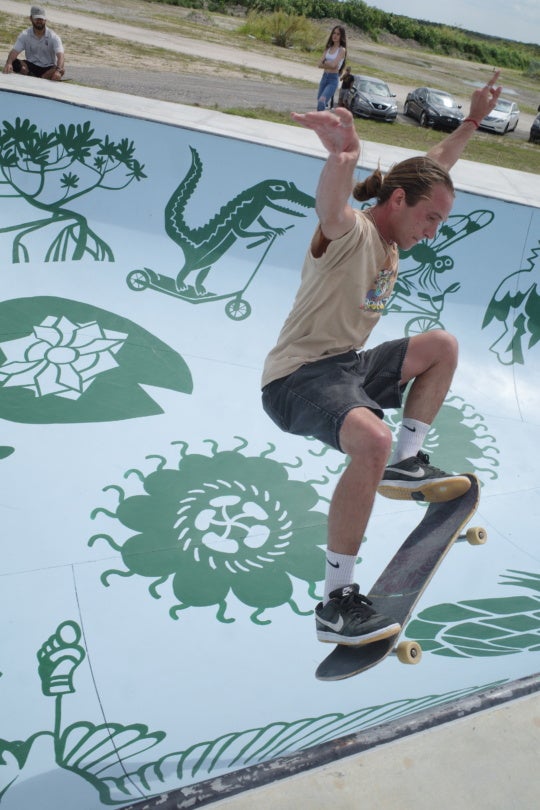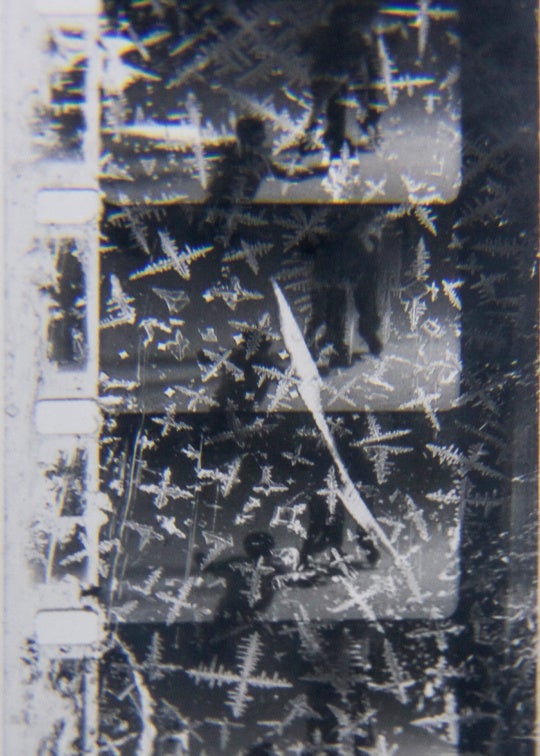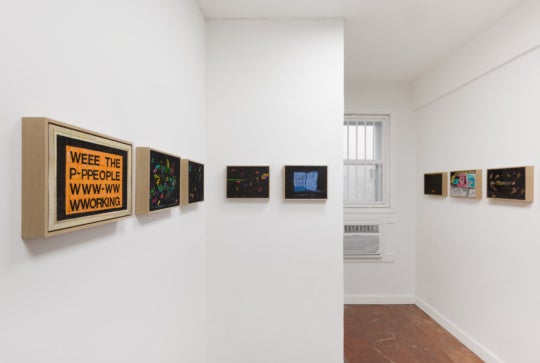
In March, artist Paul Stephen Benjamin sat down with Bethany Collins at the Dancing Goats coffee shop in Decatur to catch up on what she has been up to since receiving her MFA in 2012 from Georgia State University, where the two met. Collins, who is a finalist for the Hudgens Prize, to be awarded on June 13, fills us in on the various residencies she’s been attending, including her year-long stay at the Studio Museum in Harlem, and the new direction her work is taking.
Paul Stephen Benjamin: There are quite a few things going on with you. In 2012, you received your BFA from Georgia State. Bring me up to date, what else has been going on?
Bethany Collins: I spent the year after graduating getting established in Atlanta while also teaching at a community college in town. That was a busy year; everything was overlapping. I was teaching and finishing my MFA, finishing my thesis, and getting my practice together as a fresh out-of-school artist. And then a year after finishing school, I applied to the Studio Museum in Harlem residency, which has always been a kind of epitome space in my mind. And I got it! I want to say I was surprised, can I say surprised?
PSB: Yes.
BC: I started the residency in 2013 with two other artists, Kevin Beasley and Abigail DeVille.
PSB: Tell me about your experience there and in New York in general.
BC: It was amazing. I had never spent much time in New York other than a weekend trip, so the city was initially overwhelming, in addition to the pressure of getting something you really wanted and worked for and then feeling as though you have to live up to that. Plus, I went from teaching all day and then working in my studio whenever I caught a moment to being a full-time artist, with my practice as my primary responsibility. It’s a mind-shift.
PSB: I love New York. How did you like it?
BJC: I hated the city to begin with, and then I adored it in the end. At the end of the residency, I was sad to leave that space and the city. I’d gotten used to the pace and maybe the urgency of it. It feels like you are constantly working and you need to constantly be working. Something about that felt really rewarding. But then I came back to Atlanta, which does feels more like home. Maybe New York feels like work and Atlanta feels like home.
PSB: What was your favorite thing about New York?
BC: As opposed to just reading about exhibitions and shows that everyone is going to be talking about all year, you actually get to go see the show first. And my Studio Museum I.D. card would get me into museum shows for free.
PSB: Power, huh? (both laugh)
BC: It’s about being a part of the conversation, closer to the conversation. I do miss that part of New York.
PSB: Now that you’re back in Atlanta, do you see yourself taking quarterly trips?
BC: My home is here and I still have a studio here, but since the Studio Museum residency, I’ve been residency-bouncing from city to city and loving it.

PSB: Let’s talk about that. Right now you are at the Bemis Center for Contemporary Arts. Can you talk about that and what you are doing there?
BC: Yes, Bemis is a three-month residency. It’s in the middle of the country in Omaha, Nebraska. I figured, after moving from New York, I would need a bit of quiet time—that felt like a necessity. Omaha is super quiet. The residency is in an old renovated factory or warehouse space. The studios are so spacious. So, compared to New York, you have a sense of space everywhere around you. It’s also a live/work space, so you’re constantly waking up to your work. Whether that gets tiring or again gives you that sense of urgency, you’re always there and always working. So now I’m working on increasing scale and filling up that space.
PSB: What materials are you working with?
BC: Paper, panel, and I have been thinking more sculpturally. I like to work with found materials, like for something to meet me or to have something to react to. I’m trying to think how to move that into a three-dimensional quality but without having to make it. Bemis ends in May and then I will be heading to Miami. Going there feels like I’m going to the opposite end of the universe, and I’ll get some warmer weather.
PSB: Can you tell me about Fountainhead Residency?
BC: In looking at residencies, I look for ones that are supportive and that other artists that I know and admire have been to. Also, I want to be at residencies where I feel that I can utilize the space and dedicate the time to keep working. This is outside of the question, but I also enjoy the relationships that come out of certain residencies. Meeting artists that I would normally not get to meet, but also getting to travel and seeing how that filters into my practice.
I also enjoy not being in one particular city. Miami is next; I have not spent a whole lot of time there before, so I wanted to give it a try. It will be about two and half months that I will spend at Fountainhead and then, from there, I will be back home for the Hudgens exhibition.
PSB: Congratulations on being a finalist for the Hudgens Prize.
BC: Thank you!
PSB: Did you participate in Art Basel Miami last year?
BC: I did. Richard Gray Gallery in Chicago took my work down, but I didn’t actually get a chance to go this year.
PSB: The other thing you mentioned was networking. I’m quite sure that by being in New York and doing these different residencies that you have had a lot of opportunity to meet some really great people. How has that been in terms of expanding your experience outside of the walls of Georgia and Alabama, where you are from?

BC: The walls of my own location have expanded, but also the way that I’m working. Like a lot of other artists, I like to seclude myself in the studio. I think that was a reaction to only having a little chunk of time to do my work. Now I have a little more time and I need more interaction with others than I used to. I need other eyes. Residencies have allowed me to do that. You are kind of on this little island with up to 10 other folks not of your choosing, so it’s a little bit more random and you never know what you’re going to get.
PSB: Since graduating, you’ve had a tremendous amount of things going on in your career and artwork. How have all these different experiences informed your work? Have they brought new things to it?
BC: I want to move into more of a three-dimensional form. I feel like one of the pieces that I did at the Studio Museum,is not complete yet. And it took a year to make. I erased all of the color out of an old dictionary and, in the end, it became this color blind dictionary, super absurd and nonfunctional. It retains its function, yet it doesn’t at the same time. I would like to keep moving from there. I don’t know if that was something I would’ve done when I was here [in Atlanta] because it was so time-consuming. I have the time and resources to do things that, in the past, I would have crossed off before beginning.
PSB: Let’s shift the conversation. I believe you did some projects with Theaster Gates, whom I know from Chicago,
BC: Yes, he curated a show — right as my residency at the Studio Museum was ending — of several artists of color at Richard Gray Gallery and at Valerie Carberry Gallery in Chicago. It was called “Retreat” and coincided with his annual Black Artists Retreat. It was a great exhibition and introduced me to Richard Gray Gallery, where I will be having a solo exhibition this fall. That was a lovely introduction and it let me spend a little time in Chicago too, where I did some work for the Rebuild Foundation. It was another way to be connected to black artists who I admire and whose work I admire.
PSB: You know, Chicago is where I am from? Did you get to experience Chicago?
BC: I spent most of my time on the Southside.
PSB: Yeah, that is where I grew up.
BC: Yeah, I did a little work on the bank that they’re renovating and developing programmatically. That was fun.
PSB: I am very familiar with the Stony Island Arts Bank. What did you actually do?
BC: I worked on potential programming with Kenneth Stewart at UChicago Arts. It is such a beautiful space. I was helping with ideas around programming and thinking through how the space might be used. It was fun to be involved in the process. I got to work with some of the Rebuild staff and the Arts Incubator. I haven’t done arts administration in a long time, so it was like dusting off parts of my brain that I had not used in a while.
PSB: Let’s talk about what you have done specifically with the work and your conversation around identity.

BC: I think the work that I was making prior to the Studio Museum was primarily the “White Noise” series, chalk on chalkboards. It was dealing with language that was being asked of me or being said about me; It was being projected onto me and I was trying to find a way of dealing with that language and trying to push it outside of myself. Most of that language was race-based and it was, I think, mostly about the speaker’s attempt to identify where I belonged or where I stood. But for me, it was about trying to figure out this landscape of being black but also of being biracial, the feeling of tension between the two or the meaning between the two, and what it means to be both. I used to quote Rebecca Walker’s autobiography a lot about missing this black outline around her body, which feels like everybody else just naturally has. That felt like what my work was about: trying to fill in that outline around myself, where it feels like I am missing something here, I’m not understanding this part and I am outside of this conversation. So, that to me is what the work is about and approaching it through language.
But, I think before the Studio Museum residency even began, I solved some of those questions. I had to figure out — and it has taken me some time — my next probing question: “Why am I making work if I solved the big question I had for myself?” I’m realizing over time that using language as an approach was a tactic to get at those questions, but I’m also just really interested in language. There is a physicist, Brian Greene, who talks about his belief that the universe is coherent, which is as far as he’s even willing to go towards a belief system. He’s rational and scientific, non-faith-based, but his belief, if you want to call it that, is that the universe is coherent. I think that my belief system in my work is that language should make sense. This is how I understand the world; this is what really frustrates me about the world. Also, the ways in which the world doesn’t make sense because we’re looking at it through this prism of race. Language should be able to solve that. If we are speaking the same language, there is nothing that we shouldn’t be able to communicate and understand about each other. And yet, I know deeply that it’s a failed belief system at the same time. But that is my inherent intention, that is my question.
PSB: I like the idea about language and how that has evolved more in your work. Can you elaborate on how that has become more a part of your work?
BC: One of the effects of ending the “White Noise” series was that I wanted to fill the void of that series with space. I feel like it was getting really tight: I’m literally working super close-up on those chalkboards and working really minutely in detail. My hand was tight, but also where that work was pointing me was getting narrower and narrower. I was looking for a sense of space at the conclusion of that series and that entered into my new work, the “Contronym” series of works on paper. Contronyms are words that contain their own opposite. Scary is not necessarily a contronym, but it was the first one I did that led me to this series. My favorite so far has been quiddity, meaning both the essence of a thing and a trifling nothing. It means both of those things at the same time, and yet, somehow, it has come to exist in the world. So that series feels like we can be talking about race: it is everything and nothing, but at the same time we can be talking about 10 to 100 other things; it is everything and nothing, the coexistence and the opposite of binary. The way that language and how we understand each other has inherently failed. Also, it could be talking about many other things, that type of space feels rewarding. It feels new, it feels like fresh ground to cover. That is the direction I’m heading.
PSB: Is that also a part of the “Erasure” series?
BC: Yes, it is. I was doing some of the erasures before, but the contronyms feel like where the erasure work should’ve been heading all along.

This project is supported by the Georgia Humanities Council and the National Endowment for the Humanities and through appropriations from the Georgia General Assembly.




